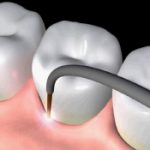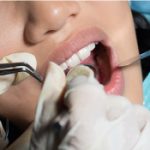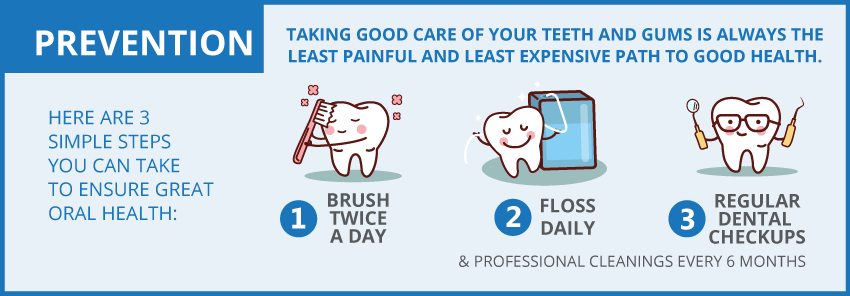What Is Gum Disease?

GINGIVITIS
Gum disease begins when plaque, a sticky deposit on the teeth where bacteria multiply, builds up on the teeth. Calcium from saliva hardens the plaque into a barnacle-like material — this calcified plaque is called tartar or calculus. Certain types of germs that live in this plaque and calculus damage gum tissue. Your body tries to fight this infection with an inflammatory attack, sending white blood cells to the area to destroy the bacteria. The inflammation then causes the tissue to bleed easily when you brush or floss.
PERIODONTITIS
If untreated, gingivitis will then progress to periodontitis. With periodontitis, calculus deposits expand on the surface of your teeth, edging down below your gum line. This condition causes your gums to separate slightly from the teeth, supporting bone and ligament, forming periodontal pockets. The infection and the pockets may continue to deepen, eating away at the jawbone until your teeth become loose and fall out.
SIGNS & SYMPTOMS OF GUM DISEASE

- Painful chewing
- Sensitive teeth or gums
- Red, swollen, or tender gums that bleed easily
- Gap between teeth and gums
- Bad breath and halitosis
- Painful chewing
- Sensitive teeth or gums
- Red, swollen, or tender gums that bleed easily
- Gap between teeth and gums
- Bad breath and halitosis
- Painful chewing
- Sensitive teeth or gums
- Red, swollen, or tender gums that bleed easily
- Gap between teeth and gums
- Bad breath and halitosis
- Pus discharge from the gums
- Loose or shifting teeth
- Receding gums or longer appearing teeth
- Changes in the way your teeth fit together when you bite
- Or no symptoms at all…
Risk Factors of Gum Disease
The number one cause of gum disease is poor dental hygiene. Neglecting to brush and floss every day can allow plaque to build up and start the inflammation of the gingiva, or the gum around the base of your teeth.
• Sugar and Acid: Eating sugars and other foods that increase the acidity in the mouth increase bacterial counts.
• Tooth Abnormalities: Teeth with cracks and crevices can trap food and encourage plaque and bacteria growth.
• Poor Dental Work: Poorly contoured fillings or crowns provide traps for debris and plaque increasing your risk.
• Wisdom Teeth: Wisdom teeth that have broken through the gum, as well as those that are impacted (buried) can be a major breeding ground for the bacteria. Gum disease can be present without any signs or symptoms.
• Teeth Grinding: Grinding teeth or having a bite that isn’t aligned can cause irritation and invisible swelling of the tiny ligaments around the teeth, also leading to dental infections.
• Adolescents: During puberty, an increased level of hormones cause increased blood circulation to the gums. This may cause increased gum sensitivity and lead to a greater reaction to any irritation, including food particles and plaque.
• Adults: 3.6% of adults between the ages of 18 – 34 have gum disease. As people age, the risk for gum disease increases. In a study of people over 70 years old, 86% had at least moderate periodontitis and over a quarter of them had lost their teeth.
• Pregnancy: Hormonal changes during pregnancy can exacerbate existing gingivitis, which typically worsens around the second month and reaches a peak in the eighth month.
• Menopause: Estrogen deficiency after menopause reduces bone mineral density, which can lead to bone loss. Bone loss is associated both with gum disease and osteoporosis. During menopause, some women may also develop a rare condition called menopausal gingivostomatitis, in which the gums are dry, shiny, and bleed easily. Women may also experience abnormal tastes and sensations (such as salty, spicy, acidic, burning) in the mouth.
• Genetics: Up to 30% of adults are genetically susceptible to gum disease.
• Closeness: Gum disease can be contagious. They infect others through saliva which can be passed through kissing, toothbrushes, eating utensils, straws or anything that touches saliva.
• Household Income: Gum disease appears in greater numbers among the poor. In particular, gum disease affects poor children and elderly people as well as racial minorities. Those with fewer financial resources for dental visits show the greatest amounts of oral bacteria.
• Medication: Certain medications or medical treatments, such as chemotherapy, can have a side effect of gum disease.
• Other Diseases: Studies have shown systemic diseases have been linked to gum disease, such as diabetes, osteoporosis, cancer, heart disease and stroke. Also, diseases which decrease your immunity, like HIV/AIDS, leukemia, multiple sclerosis, or rheumatoid arthritis, have also been known to increase your risk of gum disease.
Treatment Options
 LANAP Treatment
LANAP Treatment
LANAP is a laser treatment option and focuses on eliminating the infection around the implant. A fiber, the width of 3 human hairs, is inserted between the implant and the gum. Laser energy kills the bacteria, vaporizes cement, and stimulates stems cells found in your bone to reduce the infection and promote healing. Read More
 Alternative Surgical Option
Alternative Surgical Option
A periodontist uses a scalpel to cut your gums and fold them back. This allows the doctor to access to the tooth root to clean the target from the tooth and view the alveolar bone. If needed, the bone may be reshaped, and bone graft material is placed in the surgical site. The top of the gums may be cut back to make the pocket less deep and easier to keep clean. The gums are sewn back together. Read More

